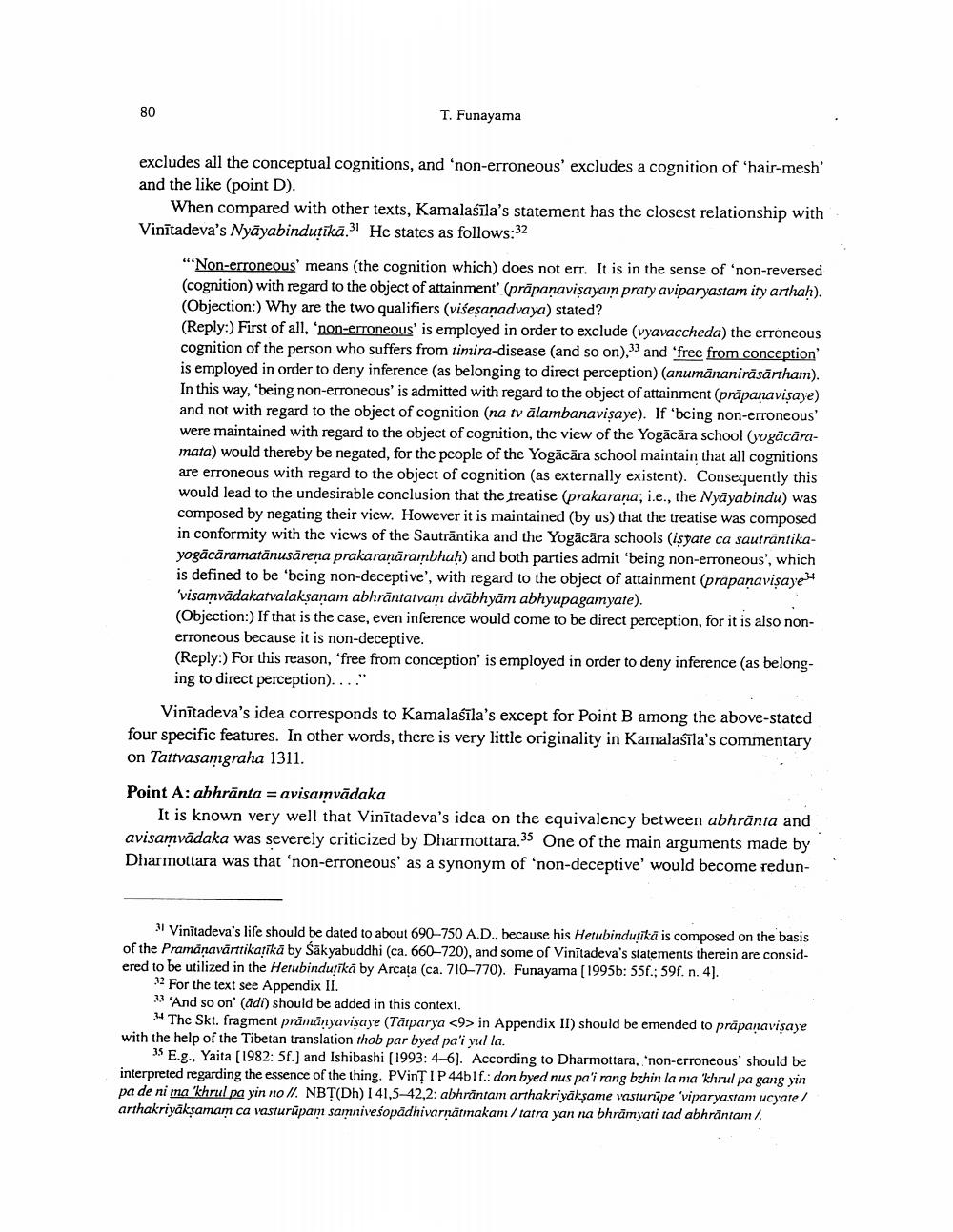________________
T. Funayama
excludes all the conceptual cognitions, and 'non-erroneous' excludes a cognition of 'hair-mesh and the like (point D).
When compared with other texts, Kamalaśīla's statement has the closest relationship with Vinītadeva's Nyāyabindutikā.3! He states as follows:32
"Non-erroneous means the cognition which) does not err. It is in the sense of 'non-reversed (cognition) with regard to the object of attainment (präpanavisayain praty aviparyastam ity arthah). (Objection:) Why are the two qualifiers (viseşanadvaya) stated? (Reply:) First of all, 'non-erroneous' is employed in order to exclude (vyavaccheda) the erroneous cognition of the person who suffers from timira-disease (and so on), and 'free from conception is employed in order to deny inference (as belonging to direct perception) (anumānanirāsārtham). In this way, being non-erroneous' is admitted with regard to the object of attainment (präpanavisaye) and not with regard to the object of cognition (na tv alambanavisaye). If 'being non-erroneous were maintained with regard to the object of cognition, the view of the Yogācāra school (yogācāramata) would thereby be negated, for the people of the Yogācāra school maintain that all cognitions are erroneous with regard to the object of cognition (as externally existent). Consequently this would lead to the undesirable conclusion that the treatise (prakarana; i.e., the Nyayabindu) was composed by negating their view. However it is maintained (by us) that the treatise was composed in conformity with the views of the Sautrāntika and the Yogācāra schools (isgate ca sautrāntikayogācāramatānusārena prakaranārambhah) and both parties admit 'being non-erroneous', which is defined to be 'being non-deceptive', with regard to the object of attainment (präpanavisaye visamvädakatvalaksanam abhrāntatvam dväbhyam abhyupagamyate). (Objection:) If that is the case, even inference would come to be direct perception, for it is also nonerroneous because it is non-deceptive. (Reply:) For this reason, 'free from conception' is employed in order to deny inference (as belonging to direct perception)...."
Vinītadeva's idea corresponds to Kamalaśīla's except for Point B among the above-stated four specific features. In other words, there is very little originality in Kamalaśīla's commentary on Tattvasamgraha 1311.
Point A: abhrānta = avisamvādaka
It is known very well that Vinītadeva's idea on the equivalency between abhrānta and avisamvādaka was severely criticized by Dharmottara.35 One of the main arguments made by Dharmottara was that ‘non-erroneous' as a synonym of 'non-deceptive' would become redun
Vinitadeva's life should be dated to about 690-750 A.D., because his Hetubindutikā is composed on the basis of the Pramanavärttikaríkā by Śäkyabuddhi (ca. 660_720), and some of Vinītadeva's statements therein are considered to be utilized in the Herubinduļikā by Arcata (ca. 710–770). Funayama (1995b: 55f.: 59f. n. 4).
2 For the text see Appendix II.
And so on' (adi) should be added in this context.
34 The Skt. fragment prämänyavisaye (Tātparya <9> in Appendix II) should be emended to präpanavisaye with the help of the Tibetan translation thob par byed pa'i yul la.
35 E.g., Yaita (1982: 5f.) and Ishibashi (1993:4-6). According to Dharmottara, 'non-erroneous' should be interpreted regarding the essence of the thing. PVinȚIP 44b1f.: don byed nus pa'i rang bzhin la ma 'khrul pa gang yin pa de ni ma 'khrul pa yin no II. NBT(Dh) I 41,5 42,2: abhrāntam arthakriyaksame vasturūpe 'viparyastam ucyate/ arthakriyākşamam ca vasturüpam samnivesopādhivarnätmakam / tatra yan na bhrämyati tad abhräntam/.




